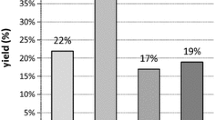Abstract
Larch wood is structurally classified in many countries as one of conifers with the highest load-bearing capacity (strength class of C30). The Spanish visual classification regulation only assigns a strength class to 4 pine woods: Laricio pine (Pinus nigra Arn. var. Salzmannii), Silvestre pine (Pinus sylvestris L.), Radiata pine (Pinus radiata D. Don), and Pinaster pine (Pinus pinaster Ait.). This work adds to the number of structurally characterised species by creating a visual classification table for Japanese larch wood (Larix kaempferi (Lamb.) Carr.) which differentiates between 2 visual classes, MEG-1 and MEG-2. Characteristic strength values were calculated for each class (fk,MEG-1 = 31.80 MPa, fk,MEG-2 = 24.55 MPa), mean module of elasticity (E0,mean,MEG-1 = 13,082 MPA, E0,mean,MEG-2 = 12,320 MPA) and density (ρk,MEG-1 = 456.6 kg m−3, ρk,MEG-2 = 469.1 kg m−3), before finally assigning a strength class of C30 to visual class MEG-1, and a strength class of C24 to visual class MEG-2.






Similar content being viewed by others
References
BS 4978:2007+A2:2017 Visual strength grading of softwood—specification. British Standard Institution (BSI), London, United Kingdom
Bunetti M, Burato P, Cremonini C, Negro F, Nocetti M, Zanuttini R (2016) Visual and machine grading of larch (Larix decidua Mill.) structural timber from the Italian Alps. Mater Struct 49:2681–2688. https://doi.org/10.1617/s11527-015-0676-5
Cáceres CB, Hernández RE, Fortin Y, Beaudoin M (2017) Wood density and extractive content variation among Japanese larch (Larix kaempferi [Lamb.] Carr.) progenies/provenances trials in eastern Canada. Wood Fiber Sci 49(4):363–372
Dauksta D (2011) Japanese larch in Wales. Wales Forest Business Partnership, Woodknowledge Wales, p 28
Dauksta D (2015) Japanese larch: how cultural differences incluence utilization of timber. Wiston Churchill Memorial Trust, The Frank Jackson Fundation, p 57
EN 338:2016. Structural timber—strength classes. European Committee for Standardization (CEN), Brussels
EN 384:2016. Structural timber—determination of characteristic values of mechanical properties and density. European Committee for Standardization (CEN), Brussels
EN 408:2010+A1:2012. Timber structures—structural timber and glued laminated timber—determination of some physical and mechanical properties. European Committee for Standardization (CEN), Brussels
EN 1309-3:2018. Round and sawn timber—methods of measurements—part 3: features and biological degradations. European Committee for Standardization (CEN), Brussels
EN 1912:2012. Structural timber—strength classes—assignment of visual grades and species. European Committee for Standardization (CEN), Brussels
EN 14081-1:2016. Timber structures—strength graded structural timber with rectangular cross section—part 1: general requirements. European Committee for Standardization (CEN), Brussels
EN 14358:2016. Timber structures—calculation and verification of characteristic values. European Committee for Standardization (CEN), Brussels
EN 14081-2:2018. Timber structures—strength graded structural timber with rectangular cross section—part 2: machine grading. European Committee for Standardization (CEN), Brussels
EN 14081-3:2012+A1:2018. Timber structures—strength graded structural timber with rectangular cross section—part 3: machine grading; additional requirements for factory production control. European Committee for Standardization (CEN), Brussels
Fortuna B, Plos M, Šuligoj T, Turk G (2018) Strength grading of structural timber. Udruga hrvatskih građevinskih fakulteta. https://doi.org/10.31534/CO/ZT.2018.09
Jeong GY, Park MJ (2016) Evaluate orthotropic properties of wood using digital image correlation. Constr Build Mater 113:864–869. https://doi.org/10.1016/j.conbuildmat.2016.03.129
Jung-Kwon O, Kwang-Mo K, Jun-Jae L (2010) Use of adjacent knot data in predicting bending strength of dimension lumber by X-ray. Wood Fiber Sci 42(1):10–20
Luo WL, Ren HQ, Wang ZH, Luo XQ (2012) Mechanical grading of structural larch dimension lumber. Key Eng Mater 517:683–688. https://doi.org/10.4028/www.scientific.net/KEM.517.683
Moriguchi K, Schibata N, Imai M, Yamanouchi M, Yoshida T (2016) Optimizing the parameters of a knot assessment model based on the visual grading of JAS of lumber. Jpn Wood Res Soc J-Stage 62(4):133–145. https://doi.org/10.2488/jwrs.62.133
NFB 52-001-1:2018. Règles d´utilisation du bois dans les constructions—classement visual pour employen structure pour les principales essences résineuses et feuillues Partie 1: Bois massif. French Standards Association (AFNOR), Paris
Ridley-Ellis D, Stapel P, Baño V (2016) Strength grading of sawn timber in Europe: an explanation for engineers and researchers. Eur J Wood Prod. https://doi.org/10.1007/s00107-016-1034-1
Takeda T, Hashizume T (1999) Differences of tensile strength distribution between mechanically high-grade and low-grade Japanese larch lumber II: effect of knots on tensile strength distribution. J Wood Sci 45:207–212. https://doi.org/10.1007/BF01177727
UNE 56544:2011. Clasificación visual de la madera aserrada para uso estructural. Madera de coníferas. Spanish Association for Standardization (UNE), Madrid
UNI 11035-2:2010. Legno strutturale—Classificazione a vista dei legnami secondo la resistenza meccanica—parte 2: regole per la classificazione a vista secondo la resistenza meccanica e valori caratteristici per tipi di legname strutturale. Italian National Unification Body (UNI), Rome
Zhu J, Nakano T, Tokumoto M (2000) Variation of tensile strength with annual rings for lumber from the Japanese larch. J Wood Sci 46:284–288
Acknowledgements
We thanks to Basque centre of research and applied innovation in vet (TKNIKA), Centre for services and promotion of Castilla y León forestry and its industry (CESEFOR), D. Bixente Dorronsoro, Gipuzkoa provincial council, and Commercial services of the wood of Guipuzkoa (SECOMA). Larrañaga sawmill (Azpeitia).
Author information
Authors and Affiliations
Corresponding author
Additional information
Publisher's Note
Springer Nature remains neutral with regard to jurisdictional claims in published maps and institutional affiliations.
Project funding: The project has been funded by Basque centre of research and applied innovation in vet (TKNIKA).
The online version is available at http://www.springerlink.com
Corresponding editor: Yu Lei.
Rights and permissions
About this article
Cite this article
Barriola, MJ., Aira, JR. & Lafuente, E. Visual grading criteria for Japanese larch (Larix kaempferi) structural timber from Spain. J. For. Res. 31, 2605–2614 (2020). https://doi.org/10.1007/s11676-019-01025-5
Received:
Accepted:
Published:
Issue Date:
DOI: https://doi.org/10.1007/s11676-019-01025-5




